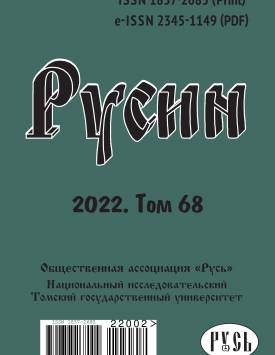Basic colour terms in the lexical-semantic field of colour in the Rusin language
The main goal of this research is to present basic colour terms in the lexical-semantic field of colour of the Backa-Srem Rusin (Ruthenian) chromatic terminology, which has not been studied in Slavic studies so far. Rusin equivalents to the basic colour terms distinguished by Brent Berlin and Paul Kay in their work Basic Color Terms: Their Universality and Evolution (white, black, red, green, yellow, blue, brown, purple, pink, orange, gray) are bila, cams, cevena , Helena, zovta/zolta , belava, braon, llova , celova , pomarancecova/pomarandzecova and siva; the equivalents zovta and pomarancecova are characteristic for the inhabitants of Ruski Krstur whereas the equivalents zolta and pomarandzecova are characteristic for the inhabitants of Kucura. The research corpus is mainly composed of Serbian-Ruthenian Dictionary and Ruthenian-Serbian Dictionary. The analysis has shown that the basic colour terms often coincide in two genetically related languages such as Rusin and Serbian but there are many important differences. The Rusin lexeme bila has the equivalents bela and plava in Serbian, and the Rusin lexeme belavahas the equivalents plavaand sedain Serbian when naming hair or beard. There are several cases when an adjective that conveys a given colour is necessary in one language but not in the other (e.g. Rusin cibul'a : Serbian crniluk, Rusin zel'ena pasul'a : Serbian boranija). Most of the chromatic terms are of Slavic origin (“ belv > bila, “сыпъ> cama, “siv>siva, “zelenъ >zel'ena, “ztv>zolta/zovta) but loanwords have been increasingly used for nuanced purposes, e.g. azurna, teget, akvamarin, tirkizna in recent decades; some of them remain unchanged, e.g. blond, braon, drap, krem, bez and oker in both languages, and lila and roze only in Serbian. The lexeme colour in both researched Slavic languages is not of Slavic origin; the lexeme boja in the Serbian language originates from Turkish (Turkish boya), and the lexeme farba in Rusin (as well as in Serbian when the term refers to non-linguistic entities) is of German origin (German farbe).
Keywords
lexical-semantic field of colour, Slavic chromatic terminology, Berlin-Kay theory, basic colour terms, loanwords, Rusin language, лексично-семантичне польо фарби, славянска хроматска терминолоґия, Берлин-Кейова теория, термини за основни фарби, пожички, руски язикAuthors
| Name | Organization | |
| Fejsa Mikhaylo | Univerzitet u Novim Sadze | fejsam@gmail.com |
References

Basic colour terms in the lexical-semantic field of colour in the Rusin language | Rusin. 2022. № 68. DOI: 10.17223/18572685/68/13
